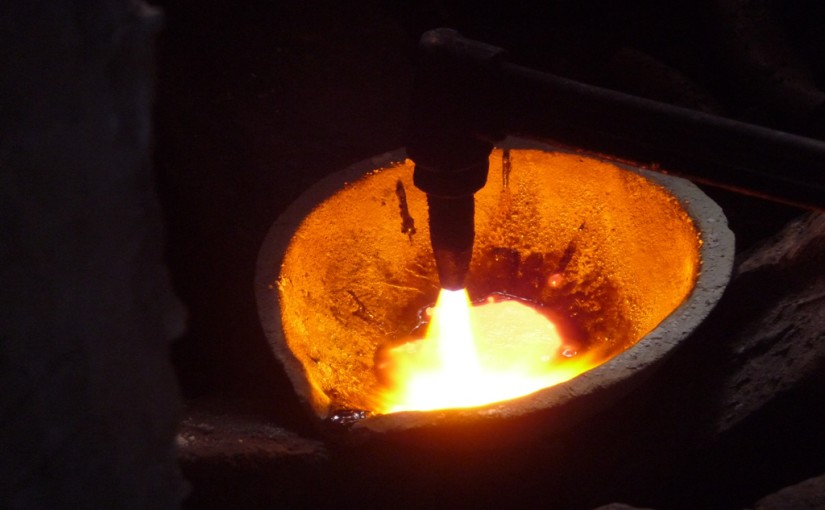When it is soooo hot out, I think of everything melting… the whole world melting.
And I wanted to melt a penny. Just to see.
Keep in mind that pennies aren’t solid copper and never have been. The ones before 1982 (and some of that year) were 97.5 percent copper, and 2.5 percent zinc. But copper got expensive, and modern pennies are zinc with a thin coat of copper.
So I want to experiment with an older penny.
First question: Can you melt copper with ordinary flame, or does it require something more intense?
Here’s what I learned.
First of all, it’s illegal to melt down pennies for profit. I ran across this in my research about the legalities of making art with legal tender: Since 2006 both pennies and nickels are “protected” under regulations of the U.S. Mint.
This is partly because they want to prevent companies from gathering up pennies and melting them for profit, thus costing the government money to replace them. Possibly it could be OK for regular folks to melt a few coins, but who wants to take the chance when there’s a $10,000 fine?
The Mint acknowledges that
Prevailing prices of copper, nickel and zinc have caused the production costs of pennies and nickels to significantly exceed their respective face values.
Apart from the legal questions, though, there’s a much bigger obstacle.
Copper has to reach 1,981 degrees Fahrenheit before it will melt. Yikes! I think that means doing it in a fire pit is out.
(I once covered a murder trial in which one of the technical experts testified that human bones cannot be completely burned in a burn barrel. They require 700 degrees Fahrenheit, at least. )
EHow helpfully suggested melting it in an iron pan … as long as you don’t use that pan for anything else, since the metals could contaminate your food. Hmm. I would have to buy an old one somewhere, or maybe use the one that’s gotten partially pitted with rust.
But the idea of heating a pan on my stove, in my kitchen, to 1,981 degrees … that seems dangerous even to me.
For now, I’ll stick with imagining it. And for today’s penny, I chose a 2006 – the first year of the anti-melting regulation. This one looks like it’s turning into something else (and anyhow, it’s got very little copper):
Here’s the notes from EHow:
Preparation
Before trying any of these copper-melting methods, prepare the copper and prepare yourself. The copper should be clean and free of debris, as well as any attached metals or materials that might have different melting points or be dangerous to burn. No matter how you choose to melt copper scrap, always wear gloves and goggles. If you use the stove top or blowtorch method, a mask of some sort would be a good idea, as the copper may “pop” while melting and splatter you with molten metal.
Stove-Top Method
Your stove can actually be used to melt copper scraps. Place the scraps in an iron pan and cover it. Turn the stove top temperature to high and remove the cover to check on your progress every few minutes. Reserve the iron pan for this specific purpose and do not mix it with your normal cooking utensils. Do not try this with a copper pan since it will obviously melt at this high temperature.
Read more : http://www.ehow.com/info_8795882_simple-ways-melt-copper-scrap.html
Or here’s another recipe:
Melt Copper on a Stovetop
Place a cast iron skillet on an electric stovetop and allow it to heat for 15 to 20 minutes. Once the skillet is heated, place the copper pieces into it and cover with a lid. Allow the copper wire pieces to soften and then stir. Keep checking the melting copper until it liquefies completely. Make sure the stovetop does not keep switching on and off, as this will prevent the copper from melting. Use protective gloves and goggles while melting the copper. Use borax, potash or graphite to prevent oxidization.
Read more : http://www.ehow.com/info_8643863_easy-ways-melt-copper.html

